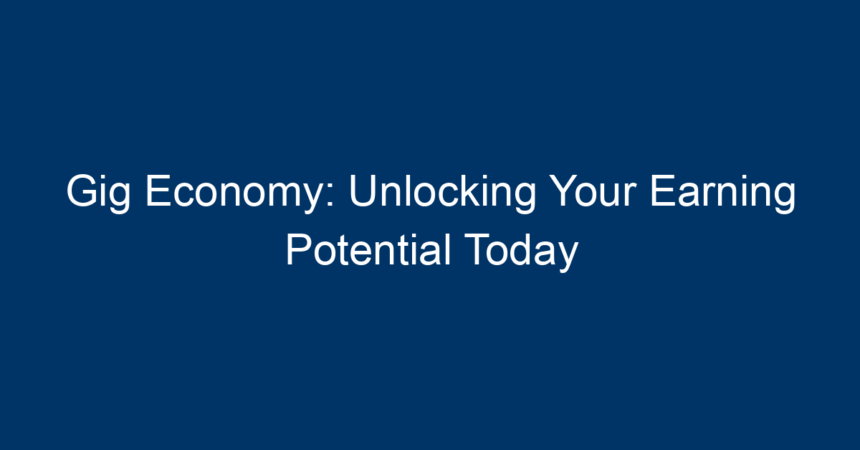In recent years, the gig economy has transformed the way we work, providing individuals with innovative opportunities to earn money on their own terms. As traditional employment structures evolve, the flexible nature of gig work has attracted millions, allowing for diversification in income sources and greater work-life balance. This article explores the dynamics of the gig economy, its benefits, challenges, and actionable strategies for unlocking your earning potential today.
What is the Gig Economy?
The term "gig economy" refers to a labor market characterized by short-term contracts or freelance work rather than permanent jobs. This model encompasses a wide range of jobs, from ride-sharing (like Uber and Lyft) to freelancing in fields such as graphic design, writing, and programming. The rise of technology and digital platforms has made it easier than ever to participate in this economy, offering unprecedented flexibility and independence.
The Rise of the Gig Economy
The gig economy began to flourish in the late 2000s, fueled by advancements in technology and a shift in workforce dynamics. Economic uncertainty and changing attitudes toward traditional jobs led many individuals to seek alternative forms of employment. According to a report by Statista, over 36% of U.S. workers engage in some form of gig work, and this figure is expected to grow.
Key Drivers of Growth
- Technology and Apps: Platforms like TaskRabbit, Fiverr, and Upwork have streamlined the connection between service providers and clients, making gig work more accessible.
- Changing Workforce Demographics: Millennials and Gen Z prioritize flexibility and passion over stability, driving them towards gig opportunities that align with their lifestyle.
- Economic Conditions: During economic downturns, individuals turn to gig work as a means to supplement income or gain financial independence.
Benefits of Participating in the Gig Economy
Flexibility
One of the fundamental appeals of the gig economy is flexibility. Workers can choose when, where, and how much they work, allowing for a tailored work-life balance. This adaptability enables individuals to juggle various responsibilities, whether it’s family commitments, education, or additional freelance projects.
Diverse Income Streams
Gig work allows individuals to diversify their income, reducing reliance on a single paycheck. By exploring various platforms and services, workers can tap into multiple revenue streams, enhancing financial security. This diversity empowers individuals to pursue their passions while earning income simultaneously.
Skill Development
Engaging in gig work often requires individuals to step out of their comfort zones. This exposure fosters the development of new skills and competencies, enriching professional experiences. Workers in the gig economy often find themselves learning about project management, marketing, and customer relations, making them more marketable in the long run.
Networking Opportunities
Gig work connects individuals with clients and other professionals from diverse backgrounds. These relationships can lead to future job opportunities and collaborations, expanding one’s professional network significantly.
Overcoming Challenges in the Gig Economy
While the gig economy offers numerous benefits, it is not without its challenges. Understanding these obstacles can help individuals navigate the landscape more effectively.
Inconsistent Income
One of the most significant downsides of gig work is the unpredictability of income. Freelancers and gig workers may experience high earning periods followed by dry spells. To mitigate this, individuals should:
- Create a budget: Track expenses and set limits to manage finances effectively.
- Build an emergency fund: Aim to save at least three to six months’ worth of living expenses.
Lack of Benefits
Traditional jobs often provide health insurance, retirement plans, and paid leave, while gig workers frequently miss out on these advantages. To counter this, individuals can:
- Explore health coverage options: Look for independent medical insurance policies or government programs such as the Affordable Care Act.
- Set aside funds for retirement: Research individual retirement accounts (IRAs) or self-employed retirement plans.
Marketing Yourself
Standing out in a crowded gig marketplace can be daunting. Effective self-promotion is crucial to attract clients and grow your freelancing portfolio. Here are some strategies:
- Build a professional website: Showcase your skills, past projects, and client testimonials.
- Utilize social media: Leverage platforms like LinkedIn, Twitter, and Instagram to establish your presence and connect with potential clients.
How to Get Started in the Gig Economy
Identify Your Skills
Assess your skills and interests to determine what types of gig work align with your strengths. Whether you’re a writer, designer, or handyman, understanding your value is essential in positioning yourself within the gig economy.
Choose the Right Platforms
Numerous platforms cater to varying skills and industries. Research and select ones that align with your expertise:
- Freelancing platforms: Upwork, Fiverr, and Freelancer.
- Service-oriented platforms: TaskRabbit and Thumbtack.
- Ride-sharing and delivery services: Uber, Lyft, DoorDash, and Postmates.
Set Realistic Goals
Establish short-term and long-term goals for your gig work. Whether it’s a specific income target, number of clients, or time spent working, having clear objectives will help you stay focused and motivated.
Create a Portfolio
A well-structured portfolio is essential for showcasing your skills to potential clients. Include case studies, sample work, and testimonials to build credibility and demonstrate your expertise.
Network and Build Relationships
Engage with other gig workers and potential clients through networking events, online forums, and social media. Building strong relationships can lead to referrals, repeat business, and collaborative opportunities.
Actionable Insights for Success in the Gig Economy
- Stay Organized: Use tools like Trello, Asana, or Google Calendar to manage projects and deadlines effectively.
- Invest in Continual Learning: Take online courses or attend workshops relevant to your field to enhance your skills and stay competitive.
- Keep Track of Finances: Use accounting tools like QuickBooks or Mint to monitor earnings and manage expenses efficiently.
- Be Professional: Maintain clear communication with clients, meet deadlines, and deliver high-quality work to build a strong reputation.
Conclusion
The gig economy presents a wealth of opportunities for individuals seeking to unlock their earning potential. By embracing flexibility, developing new skills, and strategically marketing oneself, anyone can thrive in this dynamic landscape. While challenges exist, they can be navigated with planning and a proactive mindset. With the right approach, the gig economy can be a powerful path to financial independence and personal fulfillment. Start today and explore the vast opportunities that await you in the gig economy!




